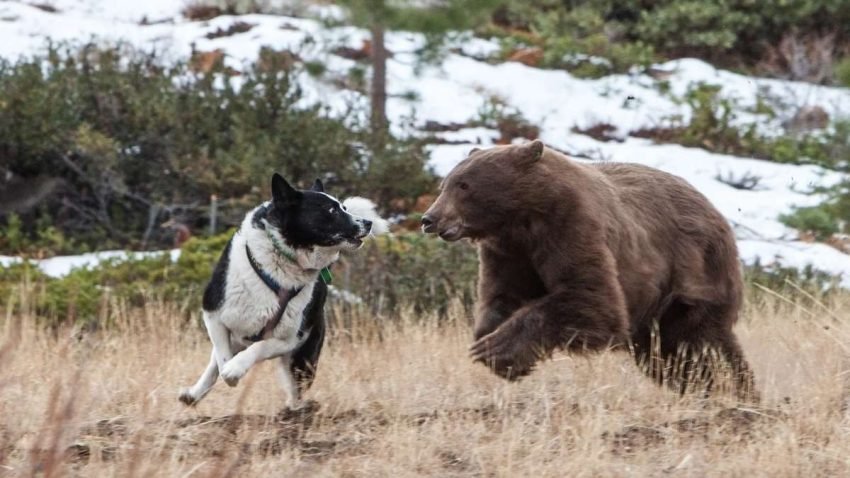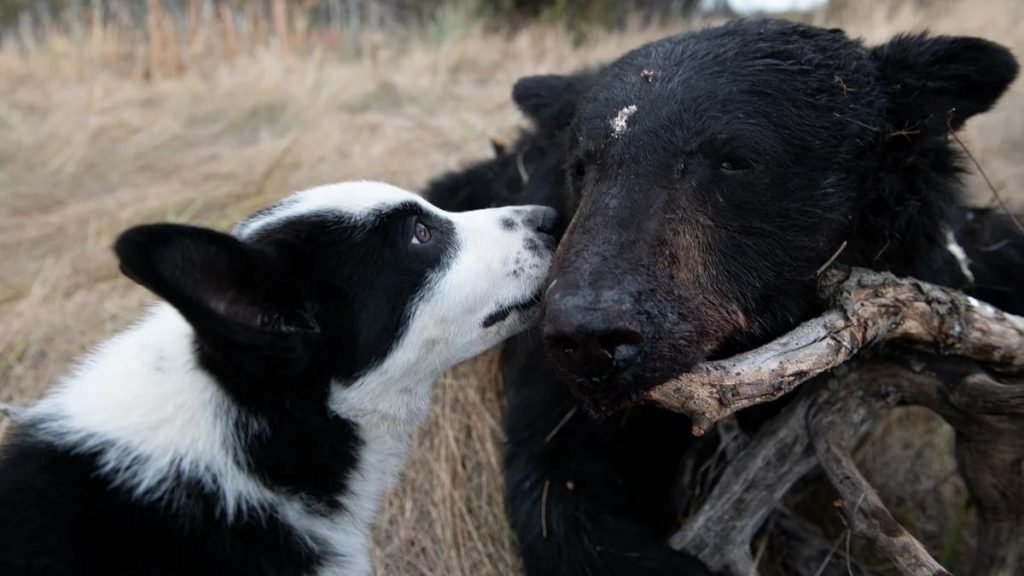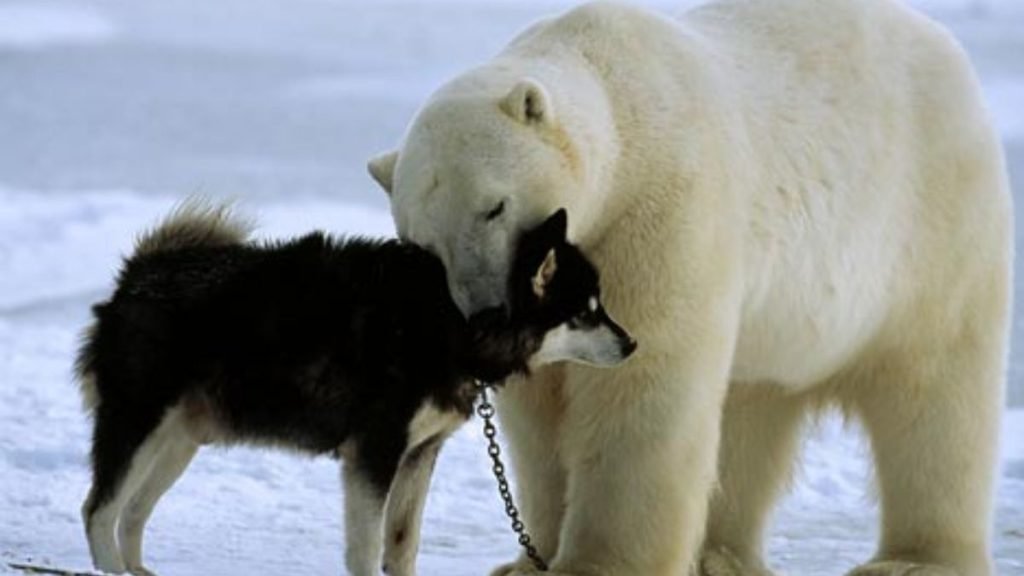Are Bears and Dogs Related?

Are bears and dogs related? This fascinating question leads us to an extraordinary discovery – these seemingly different animals share a common ancestor that lived between 62-32 million years ago. In fact, both bears and dogs belong to the same suborder called Caniformia, alongside wolves, foxes, and raccoons.
Scientists have identified that the most recent common ancestor between bears and dogs was a group called Miacids, which survived for at least 28 million years. Additionally, while bears and dogs have evolved into distinct families – Ursidae and Canidae respectively – they maintain several surprising connections. The relationship extends even further, as research shows that bears’ closest modern relatives are seals, sea lions, and walruses within the Carnivora order.
This comprehensive guide explores the evolutionary journey of these remarkable animals, examining their shared ancestry, genetic connections, and the scientific evidence that reveals their fascinating relationship.
Contents
The Ancient Connection Between Bears and Dogs

The evolutionary journey of bears and dogs traces back to a remarkable group of small, carnivorous mammals known as Miacids, who roamed Earth between 62-32 million years ago. These ancient creatures survived for at least 28 million years, establishing themselves as the foundation for modern carnivores.
Miacids were small, weasel-like creatures about the size of modern housecats. These ancient mammals possessed several distinctive characteristics:
- Tree-dwelling abilities
- Carnivorous diet focusing on insects and small prey
- Retractable claws similar to modern cats
- Broad back molar teeth resembling modern dogs
How they evolved differently
The evolutionary paths of bears and dogs diverged significantly over millions of years. Specifically, the split occurred approximately 44.9 million years ago. Consequently, bears developed into the Ursidae family, whereas dogs emerged within the Canidae family.
Moreover, geographical locations played a crucial role in shaping their evolution. In North America and Europe, the need for dietary versatility led to more omnivorous traits, particularly evident in bears. The first true bears appeared about 25 million years ago during the Oligocene epoch.
Dogs, notably, evolved from a group called Hesperocyon, which dominated as primary predators between 40 to 35 million years ago. Subsequently, these animals gave way to Eucyon, which ultimately led to the emergence of modern dogs. Throughout this process, both species adapted to different ecological niches – bears becoming solitary omnivores requiring substantial food intake for winter hibernation, whereas dogs developed into social hunters.
The relationship between bears and dogs extends beyond their common ancestor. Both species belong to the suborder Caniformia, which encompasses various other animals including wolves, foxes, raccoons, and mustelids. This classification explains their shared traits, such as non-retractable claws and omnivorous capabilities.
DNA Evidence Reveals New Links
Recent scientific breakthroughs have unveiled fascinating genetic connections that help answer the question: are bears and dogs related? Modern DNA analysis techniques have opened new windows into understanding these ancient family ties.
Latest genetic research findings
The International DoGA Consortium has created an extensive database covering more than 100 different canine tissues. This groundbreaking research collected over 5,000 samples from various dog breeds and wolves. Furthermore, scientists have developed advanced methods to study ancient DNA, successfully extracting genetic material from cave bear bones over 42,000 years old.
Comparing bear and dog genomes
The genetic similarities between bears and dogs are remarkable. Research shows that bear EST sequences demonstrate a 91.0% sequence identity with dogs. Nevertheless, the most striking discovery reveals that cave bears share approximately 93% of their DNA with modern dogs. This percentage demonstrates roughly the same genetic similarity as New World monkeys have to modern humans.
Here are the key findings from recent genetic studies:
- Bear genes show strong evolutionary constraints in heart and skeletal muscle tissues
- Scientists have mapped over 38,757 EST sequences from American black bears
- Protein-coding regions account for 72% of all assembled contig sequences
- Modern bears share about 99% of their DNA with cave bears
What makes them unique
Essentially, while bears and dogs share significant genetic material, they have evolved distinct characteristics through specific genetic variations. Primarily, these differences emerge from their separate evolutionary paths within the Caniformia suborder.
The DoGA database has essentially become a crucial resource for understanding gene regulation, serving as a vital tool for the scientific community. Accordingly, this comprehensive genetic mapping helps researchers better comprehend hereditary diseases and provides valuable information for health research in both species.
Scientists have discovered that small genetic variations can lead to substantial differences between species. For instance, in dogs, a single gene for insulin-like growth factor-1 primarily determines body size, whereas bears maintain more consistent genetic patterns for growth. These genetic distinctions highlight how each species adapted to their specific ecological roles while retaining their shared ancestral DNA markers.
Physical Traits That Show Are Bears and Dogs Related

Physical similarities between bears and dogs reveal fascinating connections that extend beyond their genetic makeup. Their shared traits offer compelling evidence of their ancient relationship within the Carnivora order.
Similar body structure
Both bears and dogs display remarkable physical resemblances in their basic anatomy. Their skeletal structure shows identical bone counts in limbs and spine. These mammals share several key physical characteristics:
- Sharp teeth with specialized carnassial features
- Four-legged body structure with non-retractable claws
- Keen sense of smell for tracking and hunting
- Fur-covered bodies adapted to their environments
Primarily, their teeth structure deserves special attention, as both species possess unique carnassial teeth that function like scissors to shear meat. Although bears are plantigrade (walking on flat feet) and dogs are digitigrade (walking on toes), their overall body structure maintains surprising similarities.
Indeed, both species demonstrate exceptional hunting capabilities. Their keen sense of smell serves as a primary tool for locating food and tracking other animals. Similarly, their sharp teeth and strong jaws enable them to handle various prey sizes effectively.
The Plott hound, recognized as the most prominent bear dog breed, showcases these shared hunting abilities. These dogs, alongside other breeds like Walker hounds and English coonhounds, possess the same tracking and hunting instincts that make bears such effective predators.
Common behavioral patterns
Generally, bears and dogs exhibit intriguing behavioral similarities, although they’ve adapted differently to their ecological roles. Bears demonstrate complex social exchanges and can form alliances, despite being often described as asocial. They establish and maintain social positions through a dominance hierarchy, with mature males at the top and cubs at the bottom.
Both species show remarkable adaptability to human presence. Bears, much like dogs, can become accustomed to people just as they do to other members of their species. However, their social structures differ significantly – bears share home ranges and resources without territorial disputes, unlike many dog breeds that display strong territorial behaviors.
The relationship between bears and dogs continues to fascinate researchers as they uncover more evidence of their shared ancestry through these physical and behavioral traits. Their similarities in body structure, hunting abilities, and certain behavioral patterns provide tangible proof of how are bears and dogs related through evolution.
Modern Bears and Dogs: Family Trees
Today’s diverse family trees of bears and dogs showcase the remarkable journey of evolution, demonstrating how are bears and dogs related through their distinct yet parallel paths. Their modern classifications reveal fascinating insights into their adaptation and development.
Types of bears alive today
Presently, eight distinct bear species roam our planet, each with unique characteristics that set them apart. These magnificent creatures range from the mighty polar bear to the diminutive sun bear:
- The polar bear, weighing up to 720 kg, stands as the largest carnivorous land mammal
- The American black bear, common across North America
- The brown bear, featuring various subspecies including the Kodiak
- The giant panda, exclusively feeding on bamboo
- The Asiatic black bear, sharing traits with its American cousin
- The spectacled bear, South America’s sole bear species
- The sloth bear, known for its termite-hunting adaptations
- The sun bear, the smallest of all bears
Obviously, these species demonstrate how are bears and dogs related through their shared characteristics, such as excellent smell sense and powerful bodies. Rather than competing, each species has adapted to specific ecological niches.
Current dog breeds
The American Kennel Club primarily organizes dogs into seven distinct groups. Certainly, this classification system helps answer the question of are bears canines by highlighting their separate evolutionary paths. The groups include:
Working Group dogs, were originally bred for tasks like guarding and pulling sleds. Sporting Group breeds excel in assisting hunters, therefore showing how are seals related to dogs through their aquatic adaptations. Likewise, the Hound Group demonstrates remarkable tracking abilities.
Straightaway, one notices the Terrier Group’s distinctive traits, bred for pursuing small prey. Soon after, the Toy Group catches attention with their compact sizes. Undeniably, the Non-Sporting Group presents diverse characteristics, while the Herding Group showcases remarkable livestock-management abilities.
The diversity among modern dog breeds proves fascinating when considering are bears related to dogs through their ancient connection. With over 450 recognized dog breeds today, these animals demonstrate remarkable adaptability. Primarily, this variety emerged through selective breeding, creating specialized traits for specific tasks. Are dogs and bears related? The answer lies in understanding how their separate yet parallel evolution led to such diverse family trees.
How Scientists Track Animal Relations
Scientists employ sophisticated methods to uncover how are bears and dogs related through their evolutionary journey. Modern research techniques combine traditional approaches with cutting-edge technology to paint a comprehensive picture of these species’ connections.
DNA testing methods
Genetic testing has markedly advanced our understanding of whether are bears and dogs related. Scientists extract DNA from various sources:
- White blood cells from living animals
- Hair samples from livestock and wild specimens
- Cheek swabs for domestic animals
- Ancient DNA from preserved specimens
Primarily, researchers analyze short tandem repeats (STRs) in DNA sequences, which provide crucial information about species relationships. These genetic markers show inheritance patterns across different animal groups, helping determine are bears canines or part of a different family altogether.
Fossil evidence
Museum collections play a vital role in understanding are bears related to dogs. Evidently, fossils don’t always need to be discovered in the field – many significant findings come from examining existing museum specimens. The Field Museum’s world-class fossil mammal collection, simultaneously with other institutions, provides researchers with invaluable resources for studying ancient species.
Comparatively, scientists use high-resolution X-ray CT scans to create 3D digital reconstructions of fossil skulls. These detailed images reveal internal features otherwise invisible to researchers, offering new insights into how are bears and dogs related through their anatomical structures.
Modern research tools
Initially, tracking technology has transformed animal research capabilities. Modern tools include:
- GPS trackers and radio tags for monitoring movement patterns
- Accelerometers for studying behavioral patterns
- Environmental and physiological sensors
- Audio-visual recording capabilities
Are Bears And Dogs Related Frequently Asked Questions
Bears and dogs share a common ancestor that lived between 62-32 million years ago. While they have evolved into distinct families, they both belong to the suborder Caniformia, along with other animals like wolves and foxes.
What is the closest living relative to bears?
The closest living relatives to bears are seals, sea lions, and walruses. These marine mammals, known as pinnipeds, are part of the same evolutionary branch as bears within the order Carnivora.
How genetically similar are bears and dogs?
Recent genetic studies have shown that cave bears share approximately 93% of their DNA with modern dogs. This level of genetic similarity is comparable to that between New World monkeys and modern humans.
Bears and dogs share several physical characteristics, including sharp teeth with specialized carnassial features, four-legged body structures with non-retractable claws, keen senses of smell, and fur-covered bodies adapted to their environments.
How do scientists study the relationship between bears and dogs?
Scientists use various methods to study the relationship between bears and dogs, including DNA testing, fossil analysis, and advanced tracking technologies. These techniques allow researchers to examine genetic similarities, anatomical structures, and behavioral patterns to better understand their evolutionary connections.



